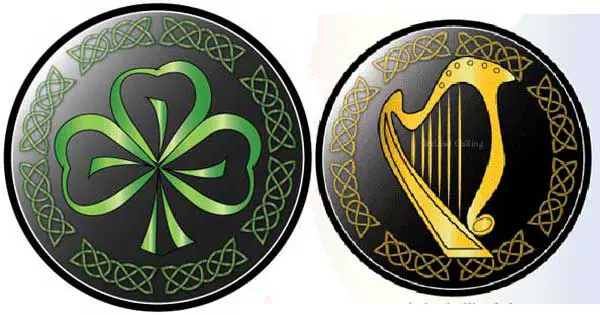The harp and the shamrock are such common symbols of Ireland that you might be forgiven for thinking that any old Tom, Dick or Harry could stick them on their logo when setting up a new business.
Not so, the Irish government is very keen to protect them and has a department devoted to ensuring they are not abused.

The harp was officially adopted as a symbol of Ireland by the new Free State government in 1922. Even 100 years ago the harp was widely used to symbolise Ireland, and Guinness had even registered its harp as a trademark way back in 1862.
It meant the new Irish government had to put its harp facing the other way on passports and official documents.
The shamrock is probably even more closely associated with Ireland and must adorn a million costumes and hats at St Patrick’s Day celebrations. It’s certainly come a long way since St Patrick immortalised it by using it as a symbol of the Holy Trinity.
The Irish government officially adopted the shamrock as a state emblem back in 1985.
Since then it has been keen to protect the harp and shamrock emblems and restrict their use.
No one is going to mind if you pop a harp and shamrock on either side or you hat on St Patrick’s Day, but it won’t be that simple if you want to use them on a logo for your new business or as part of your company’s marketing.
The emblems can’t be used without official permission. The government’s website says: “A person or company, who wishes to obtain registration of a trade mark containing a State emblem or to use a State emblem in connection with any business must first obtain consent from the Minister of Jobs, Enterprise and Innovation.
“Any queries regarding the use of a State emblem must be directed to the Intellectual Property Unit of this Department.
“The Minister is also empowered to take lawful steps against any person outside the State in the event of misuse of trade marks that would falsely indicate that the goods on which the trade mark is used were of Irish origin.”
This protection doesn’t just apply to using the harp or shamrock emblems in Ireland; it extends to more than 177 countries that have signed the Paris Convention for the Protection of Industrial Property, including the United States, the UK, Canada and Australia.
“This provision is designed to prevent, restrain or secure punishment for the registration, use or application in relation to goods not produced in the State, of any trade mark or other mark or description which is either falsely indicative of, or likely to lead to the belief, that the goods are of Irish origin.”
The control tends to be more rigidly applied to the harp emblem than the shamrock, as that was only adopted by the state in 1985.
A government spokesman told the Irish Times: “The fact is that before it was ever adopted as a state emblem, the shamrock was being used in a commercial sense by a number of companies as an indication of Irish origin.
“Our policy had to take account of this commercial reality and, for this reason, efforts have been focused on restricting use of the shamrock to companies having a real and substantive link to Ireland.”
A Freedom of Information request by the Times showed that there had been 85 applications to use the emblems between 2016 and 2019. So far 78 of those 85 have been approved, with the applicants being able to show that they had a ‘real and substantive link’ with Ireland.
You can get more information about using the harp and shamrock emblems from dbei.gov.ie.
Celtic Cross
Brigid’s Cross
How Ireland protects its harp and shamrock emblems…take care if using them
Why the Guinness harp faces the opposite way to the official Irish harp

